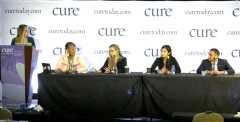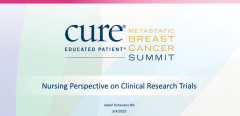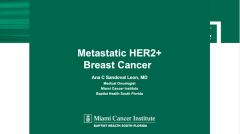
Educated Patient® Breast Cancer Summit at MBCC HER2-Positive Metastatic Disease Presentation: March 4, 2023
Watch Dr. Ana C. Sandoval Leon, from Miami Cancer Institute, Baptist Health South Florida, discuss HER2-positive metastatic disease during the CURE Educated Patient® Breast Cancer Summit at MBCC.
Episodes in this series

Outcomes for patients with metastatic HER2-positive breast cancer have improved as a result of research helping health care providers to understand the mechanisms of the protein, which has led to the development of several treatment options for patients, an expert said.
Dr. Ana C. Sandoval Leon, a breast medical oncologist at the Miami Cancer Institute, Baptist Health South Florida, in Plantation, Florida, discussed this topic at the CURE® Educated Patient® Breast Cancer Summit, held live and virtually at the Miami Breast Cancer Conference.
There are several goals of treating metastatic breast cancer such as symptom improvement and shrinking the tumor. Sandoval Leon gave an example of a patient with a bone lesion that causes pain, and if treatment can shrink the bone lesion, it may improve the pain the patient is experiencing. Another example is a patient who has a tumor in their lungs which leads to shortness of breath. Once the disease is controlled, patients may be able to breathe better even though the therapy may have some side effects.
“It’s a balance we have to take, your symptoms and the toxicity of therapies,” Sandoval Leon said.
She also highlighted a treatment goal of improving quality of life and living longer.
“What we all want is to live longer, but we want to live longer with a good quality of life,” she said. “We don’t want to live longer in bed without being able to have our regular life. We want to live longer and be able to function.”
Metastatic HER2-Positive Treatment Options
There are several systemic therapies for the treatment of
Between 1998 and 2020, several treatments have been approved by the Food and Drug Administration (FDA) for HER2-positive metastatic breast cancer including Herceptin (trastuzumab) in 1998, which “really changed the outcomes of many patients who have this disease,” Sandoval Leon said. During this time period, other drugs have been FDA approved such as Tykerb (lapatinib), a tyrosine kinase inhibitor (TKI); Perjeta (pertuzumab), an antibody similar to Herceptin; Kadcyla (ado-trastuxumab emtansine), an antibody drug conjugate; and Enhertu (fam-trastuzumab deruxtecan-nxki), another antibody-drug conjugate. Three monotherapy treatments were approved by the FDA in 2020, including Tukysa (tucatinib) and Nerlynx (neratinib), both of which are TKIs, and Margenza (margetuximab), an antibody-drug conjugate.
These drugs have different mechanisms to treat patients with HER2-positive metastatic breast cancer. For example, antibodies like Herceptin and Perjeta bind to the HER2 protein — albeit to different parts of it — to stop its function and cell growth.
“By doing that, it also decreases the cell replication, and they can work together,” Sandoval Leon said. “That’s why we use (Herceptin and Perjeta) together.”
TKIs like Tykerb, Nerlynx and Tukysa are oral medications that stop the function of the HER2 protein inside the cell. Then for antibody-drug conjugates, Sandoval Leon compared their function to a trojan horse.
“You have the chemotherapy inside the antibody,” she explained. “So the horse will be the antibody, in this case — in general, it’s Herceptin for HER2-positive breast cancer. And then the little soldiers are the chemotherapy. … By doing that, it can attack the cells that have this HER2 positivity and then it deploys the chemotherapy. The toxicity is less and is more actionable, more targetable.”
Available treatments for patients with HER2-positive metastatic breast cancer provide patients with options if they potentially move through first-, second, third- and fourth-line therapies. Firstline therapy, or the first treatment given for a disease, typically consists of Herceptin, Perjeta and a taxane, a chemotherapy. Enhertu is the common treatment for second-line therapy. There are commonly two options for third-line therapy — Tukysa, Herceptin and Xeloda or Kadcyla alone — and up to five options for fourth-line therapy and beyond.
Treatment-Related Side Effects
Side effects may be common regardless of which treatment a patient with HER2-positive metastatic cancer is undergoing, which is why it is important for patients to discuss any of these with their cancer team, Sandoval Leon said. Some of the side effects include the following:
- Herceptin: infusion reaction, heart toxicity
- Perjeta: diarrhea, infusion reaction, heart toxicity, rash that looks like acne
- Kadvyla: infusion reactions, nausea, liver-related side effects, lower platelet counts
- Tykerb: diarrhea
- Tukysa: liver toxicity, diarrhea, rash
- Margenza: infusion reaction and heart toxicity
Sandoval Leon said that the most concerning side effect of these treatments is interstitial lung disease, when scarring occurs in the lung that can cause stiffness and difficulty breathing.
“It's extremely important if you're taking Enhertu and you develop shortness of breath, cough or fever to alert your provider because there were patients that died in the clinical trial from this lung toxicity,” she said. “It was a few (patients), but it's extremely important to notice that. If you develop the symptoms, the recommendation is to start high-dose steroids. With that, most patients will do very well. And you have Tukysa, it can cause liver toxicity, diarrhea and a rash. And Margenza is also an infusion. So you can have an infusion reaction and the heart toxicity.
No matter what treatment patients with metastatic HER2-positive breast cancer may be undergoing, Sandoval Leon emphasized the importance of eating healthy and exercise. This includes eating lots of fruits and vegetables, trying not to eat red meat and lunch meat more than once a week, and avoiding alcohol and smoking. She also mentioned patients can benefit from at least 3 hours of moderate activity every week.
“Patients who exercise and eat healthy have better outcomes, and patients who exercise tolerate therapy better,” she said during her presentation.
Sandoval Leon also urged
“Always, always ask if there is a clinical trial available, either where you're seeing the physician oncologist or in a nearby hospital,” she said. “The change on treatments is thanks to all the patients that have participated in clinical trials. And that is how we can hopefully in the future eradicate this disease.”
For more news on cancer updates, research and education, don’t forget to




















